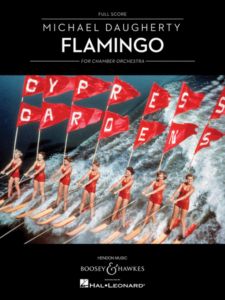Flamingo
for chamber orchestra (1991)
Instrumentation: Flute (piccolo), oboe, clarinet, bassoon; 1 or 2 horns, trumpet, trombone, 2 percussion; piano, strings (1/1/1/1/1 or small complements)
Publisher: Boosey and Hawkes, Hendon Music (BMI)
Duration: 9 minutes

Program Note:
Flamingo (1991) for chamber orchestra was commissioned by the Baltimore Chamber Orchestra, Pro Musica Chamber Orchestra of Columbus, Ohio, and Trinity Chamber Orchestra, Cleveland, Ohio and made possible by a grant from Meet the Composer funded by Readers’ Digest The world premiere was given by the Baltimore Chamber Orchestra, conducted by Anne Harrigan, with John Locke and Laurence Reese, tambourines, on May 9, 1991 at Goucher College, Kraushaar Auditorium, Baltimore, Maryland.
The composition derives its title from the iconic pink plastic flamingo designed by Don Featherstone in 1957. Pink plastic flamingos, which were usually sold in pairs, became a popular lawn ornament on manicured lawns and gardens across America. I remember noticing these plastic flamingo lawn ornaments for the first time when my father and mother drove my four brothers and me for a family vacation, in a Chevy station wagon, from Cedar Rapids, Iowa to Miami, Florida in August of 1962.
Along the way, we stopped at Winter Haven, Florida. There I witnessed, for the first time, real pink flamingos at Cypress Gardens, a water “theme park” known for its extravagant water ski shows. Cypress Gardens was also a backdrop for MGM water movie musical extravaganzas, such as Easy to Love (1953), starring bathing beauty Esther Williams. As we continued on our road trip and entered Miami, the dream was momentarily interrupted by a news flash on the car radio that the Marilyn Monroe had mysteriously died in Hollywood.
Flamingo also resonates with the “flamenco” dance and features two percussionists who perform various techniques on the tambourine such as striking, shaking, rattling, and thumb rolling. Like a pair of pink plastic flamingos, the two tambourine soloists, who are separated stereophonically on the stage, provide a lively rhythmic counterpoint to the central staccato motive first heard in the piccolo. This motive is repeated in a forward driving rhythm, creating slightly out-of-sync canons with the ensemble. A slow, melancholy section, that features a sighing bassoon, interrupts the proceedings. Led by the string section and driving tambourines, an exotic groove, reminiscent of a pyramid of show water skiers skimming the water’s surface at breakneck speed, brings Flamingo to a rousing and exciting conclusion.
—Michael Daugherty

